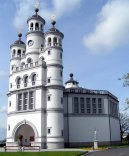| Introduction - Slovenia: |
| Location - Slovenia: |
| People - Slovenia: |
| Government - Slovenia: |
| Economy - Slovenia: |
Economy overview | With a GDP per capita substantially greater than the other transitioning economies of Central Europe, Slovenia is a model of economic success and stability for its neighbors from the former Yugoslavia. The country, which joined the EU in May 2004 and joined the eurozone on 1 January 2007, has excellent infrastructure, a well-educated work force, and an excellent central location. Privatization of the economy proceeded at an accelerated pace in 2002-05. Despite lackluster economic performance in Europe in 2001-05, Slovenia maintained moderate growth. Structural reforms to improve the business environment have allowed for greater foreign participation in Slovenias economy and have helped to lower unemployment. In March 2004, Slovenia became the first transition country to graduate from borrower status to donor partner at the World Bank. Despite its economic success, Slovenia faces growing challenges. Much of the economy remains in state hands and foreign direct investment (FDI) in Slovenia is one of the lowest in the EU on a per capita basis. Although tax reforms were implemented in December 2006, taxes are still relatively high. The labor market is often seen as inflexible, and legacy industries are losing sales to more competitive firms in China, India, and elsewhere. The current center-right government, elected in October 2004, has pledged to accelerate privatization of a number of large state holdings and is interested in increasing FDI in Slovenia. In late 2005, the governments new Committee for Economic Reforms was elevated to cabinet-level status. The Committees program includes plans for lowering the tax burden, privatizing state-controlled firms, improving the flexibility of the labor market, and increasing the governments efficiency. |
|
Gdp purchasing power parity | $47.01 billion (2006 est.) |
|
Gdp official exchange rate | $37.92 billion (2006 est.) |
|
Gdp real growth rate | 5.2% (2006 est.) |
|
Gdp per capita ppp | $23,400 (2006 est.) |
|
Gdp composition by sector | agriculture: 2.3%
industry: 34.1%
services: 63.6% (2006 est.) |
|
Labor force | 1.026 million (2006 est.) |
|
Labor force by occupation | agriculture: 4.8%
industry: 39.1%
services: 56.1% (2004) |
|
Unemployment rate | 9.6% (2006 est.) |
|
Population below poverty line | 12.9% (2004) |
|
Household income or consumption by percentage share | lowest 10%: 3.6%
highest 10%: 21.4% (1998) |
|
Distribution of family income gini index | 28.4 (1998) |
|
Inflation rate consumer prices | 2.4% (2006 est.) |
|
Investment gross fixed | 25.6% of GDP (2006 est.) |
|
Budget | revenues: $15.9 billion
expenditures: $16.35 billion; including capital expenditures of $NA (2006 est.) |
|
Public debt | 29% of GDP (2006 est.) |
|
Agriculture products | potatoes, hops, wheat, sugar beets, corn, grapes; cattle, sheep, poultry |
|
Industries | ferrous metallurgy and aluminum products, lead and zinc smelting; electronics (including military electronics), trucks, automobiles, electric power equipment, wood products, textiles, chemicals, machine tools |
|
Industrial production growth rate | 5.6% (2006) |
|
Electricity production | 14.9 billion kWh (2006) |
|
Electricity consumption | 13.71 billion kWh (2006) |
|
Electricity exports | 4.8 billion kWh (2006) |
|
Electricity imports | 4.07 billion kWh (2006) |
|
Oil production | 8 bbl/day (2004 est.) |
|
Oil consumption | 53,000 bbl/day (2004 est.) |
|
Oil exports | NA bbl/day |
|
Oil imports | NA bbl/day |
|
Oil proved reserves | 0 bbl |
|
Natural gas production | 0 cu m (2004 est.) |
|
Natural gas consumption | 1.1 billion cu m (2004 est.) |
|
Natural gas exports | 0 cu m (2004 est.) |
|
Natural gas imports | 1.1 billion cu m (2004 est.) |
|
Current account balance | -$789.2 million (2006 est.) |
|
Exports | $21.85 billion f.o.b. (2006 est.) |
|
Exports commodities | manufactured goods, machinery and transport equipment, chemicals, food |
|
Exports partners | Germany 20.1%, Italy 13%, Croatia 9.1%, Austria 8.8%, France 6.5%, Russia 4.4% (2006) |
|
Imports | $23.59 billion f.o.b. (2006 est.) |
|
Imports commodities | machinery and transport equipment, manufactured goods, chemicals, fuels and lubricants, food |
|
Imports partners | Germany 19.7%, Italy 18.1%, Austria 11.9%, France 6%, Croatia 4.7% (2006) |
|
Reserves of foreign exchange and gold | $8.631 billion (2006 est.) |
|
Debt external | $29.09 billion (30 October 2006) |
|
Economic aid recipient | ODA, $484 million (2004-06)
note: in March 2004, Slovenia became the first transition country to graduate from borrower status to donor partner at the World Bank |
|
Currency code | euro (EUR)
note: on 1 January 2007, the euro became Slovenias currency; both the tolar and the euro were in circulation from 1 January until 15 January 2007 |
|
Exchange rates | tolars per US dollar - 190.85 (2006), 192.71 (2005), 192.38 (2004), 207.11 (2003), 240.25 (2002)
note: Slovenia adopted the euro as its currency on 1 January 2007 |
|
| Communications - Slovenia: |
| Transportation - Slovenia: |
| Military - Slovenia: |
This page was last updated on 16 September, 2007



